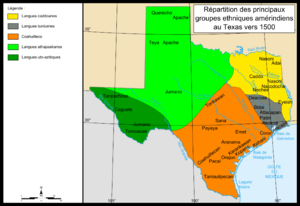Coahuiltecan languages facts for kids
Imagine a long time ago, in what is now southern Texas and parts of Mexico, many different groups of people lived. They spoke many different languages. For a while, people thought these languages were all part of one big "language family" called Coahuiltecan. This idea came from a person named John Wesley Powell in 1891.
Today, most language experts don't think all these languages were closely related. But "Coahuiltecan" is still a useful term. It helps us talk about the many different languages and people who lived in this area.
Contents
What Were Coahuiltecan Languages?
For a long time, people thought the languages spoken in southern Texas were all similar. This was because the people living there shared similar ways of life. Also, the land itself was much the same across the region.
Because of these similarities, experts suggested a "Coahuiltecan language family." This group was thought to include languages like Karankawa and Tonkawa. Some even thought these languages might be connected to Hokan. Hokan is a language family found far away in places like California and Arizona.
Were They All Connected?
Most modern language experts have a different idea. They believe the Coahuiltecan region had many different languages. It was a place with great "linguistic diversity," meaning lots of different languages were spoken.
We only know a few words from seven of these languages. These include Comecrudo, Cotoname, Aranama, Solano, Mamulique, Garza, and Coahuilteco (also called Pakawa).
A Common Language
The Coahuilteco or Pakawa language seems to have been a lingua franca. This means it was a common language used by different groups to talk to each other. Many Coahuiltecan people used it, especially those living near the Catholic Missions in San Antonio during the 1700s.
Many more languages were likely spoken in the region. But sadly, many Coahuiltecan groups disappeared between the 1500s and 1800s. Their languages were never written down or recorded.
The Last Speakers
In 1886, a researcher named Albert Samuel Gatschet found some of the last people who spoke these languages. He found 25 people who spoke Comecrudo, one who spoke Cotoname, and two who spoke Pakawa. They were living near Reynosa, Mexico.
Around 1690, about 100,000 Native Americans may have lived in northeastern Mexico and southern Texas. Over time, many Coahuiltecans faced hard times. Some were taken as captives. Many others became sick from new illnesses brought by Europeans. Others joined the Hispanic population.
What We Know Now
Language experts think that Comecrudo, Mamulique, and Garza might be related. Coahuilteco and Cotoname might also be connected. Comecrudo and Cotoname are the languages we know the most about. They were spoken near the delta of the Rio Grande.
We don't have enough information to classify Solano and Aranama. Some experts believe that all these languages should be seen as "language isolates." This means they are not clearly related to any other known language. There just isn't enough information to prove a connection.
Today, the Coahuiltecan languages and cultures are no longer spoken. However, the names of many groups have been remembered. These include the Ervipiame, Mayeye, Pajalat, Quems, Quepano, Solano, and Xarames.


